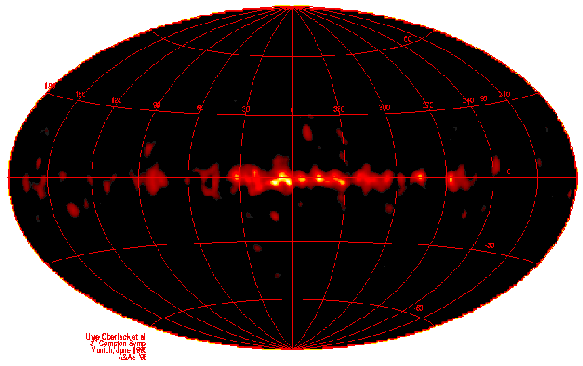Astronomy Picture of the Day
Discover the cosmos!
Each day a different image or photograph of our fascinating universe is
featured, along with a brief explanation written by a professional
astronomer.
July 24, 1996

COMPTEL Explores The Radioactive Sky
Credit :
The COMPTEL Collaboration,
Compton Gamma Ray Observatory,
NASA
Explanation:
Diffuse gas
clouds laced with radioactive aluminum atoms
(Al26) line the plane of our Milky Way
Galaxy!
How do we see them?
Relying on
the Compton Effect,
the COMPTEL instrument onboard NASA's
immense orbiting Compton Gamma Ray Observatory
can "see" the 1.8 million electron Volt
gamma rays emitted by the
radioactive decay.
COMPTEL's first ever survey
image of the entire sky in the light
of gamma rays produced by this exotic
radioactivity is shown above.
The Galactic plane
is horizontal, passing through
the Galactic centre in the middle of the picture, as indicated by
the superposed coordinate grid.
The radioactive Al26 clouds are
seen to lie in clumps near the plane, with some slightly above and
below it. The brightest feature looks like a mysterious inverted "V", just
to the left of centre.
Where do they come from?
Al26 decays to magnesium (Mg26) with
a half-life
of about a million years, a very short time compared to the
age of the Galaxy -- so the clouds
must have been produced relatively "recently".
COMPTEL astronomers are exploring
several origins for the radioactive clouds including
nuclear processing (nucleosynthesis) by aging massive stars
and supernova explosions.
Because they are generally thought to be associated with short lived massive
stars, the radioactive clouds are expected to be located near sites of
recent star formation.
(Note added in press:
Don't worry - the aluminum atoms in the foil in your
kitchen are Al27
and are not radioactive!)
Tomorrow's picture: Hale-Bopp on Schedule
<
Archive
| Index
| Search
| Calendar
| Glossary
| Education
| About APOD
>
Authors & editors:
Robert Nemiroff
(MTU) &
Jerry
Bonnell (USRA)
NASA Technical Rep.:
Jay Norris.
Specific rights apply.
A service of:
LHEA
at
NASA/
GSFC
&:
Michigan Tech. U.
